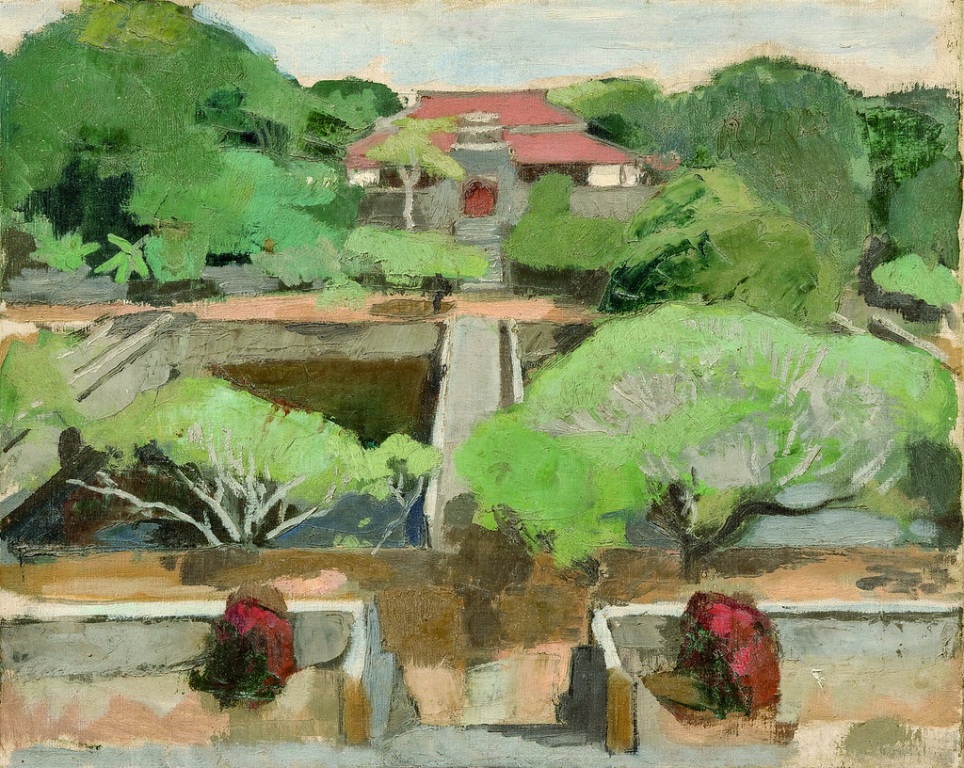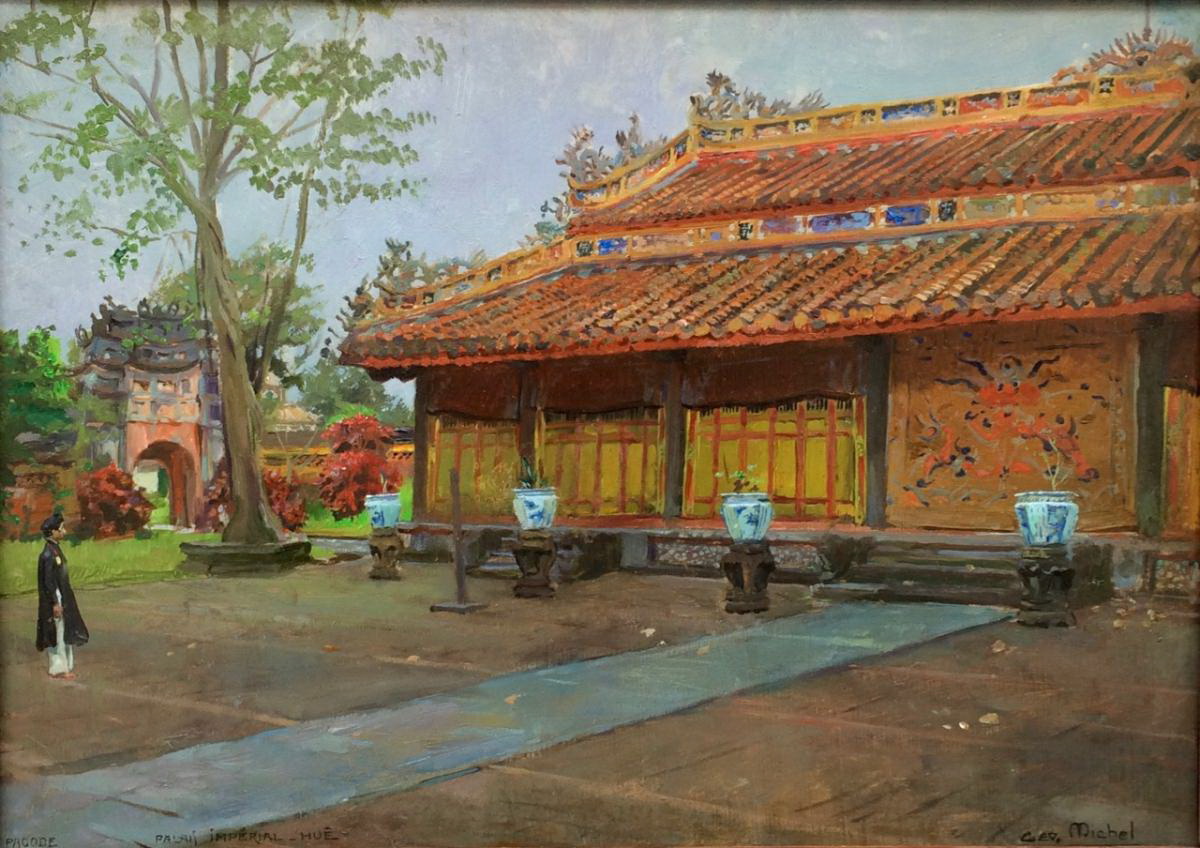
Maurice Menardeau watercolor painting of Tu Duc Tomb
1. In 2016, when I came to a friend's house in the city of St Paul, Minnesota, I was amazed to see a poster on his wall featuring young lady wearing the aodai and the non bai tho (lit. poem conical hat) against the unique background of the ancient capital city.
On a closer look, it was a kind of poster, by Jos Henri Ponchin and printed at the Exprême Orient (the Far East) printing house in Hanoi in 1931. But my friend was certainly not a collector of such antiques. Then he honestly confessed: "You just need a quick search on Amazon.com; pictures of Vietnam in the ancient days are neither rare nor expensive."
Indeed, Amazon.com has more posters by Jos Henri Ponchin featuring the images and landscapes of Vietnam: Hanoi, Northern Delta, Ha Long Bay, Ba Be Lake, Southern canals and arroyos, etc. What’s more, Jos Henri Ponchin paintings are not only reprinted for interior decoration but also introduced on many products such as pillowcases, t-shirts, handbags, housewives’ aprons, coffee bags and many other items - these are easily found at Amazon.com or Walmart stores located throughout the United States.
Joseph Henri Ponchin or Jos Henri Ponchin (1897-1981) was of the third generation of the famous Ponchin family in France, with many talented Ponchin artists whose works are now preserved in many museums in France and other countries.
In the 19th century in France, artist Louis Pascal Ponchin (1828 - 1899) began to create the family's fine arts tradition, spanning across three generations of nearly a century of art. His son Antoine Marius Simon Ponchin (1872-1933) had participated in the Colonial Exhibition in Marseille in 1922 and won the Indochinese Art Award the same year, hence receiving a business trip to Hanoi in 1922 and 1923.

Thai Hoa Palace painted by Géo Michel
On April 4th 2016, at the auction of Southeast Asian modern and contemporary art works by the Sotheby's in Hong Kong, the oil painting of Thai Hoa palace front view in Hue (small size 65cm x 54cm), painted on paper by Antoine Ponchin in the 1920s with a special lacquer frame made at that time, was sold for nearly USD 10,000.
As for Jos Henri Ponchin, after traveling with his father to Hanoi, he stopped in Saigon to teach painting to French students at a secondary school and continued to live in Vietnam until 1931. Especially, he received orders to paint a series of posters to promote the French Indochina: Vietnam, Cambodia and Laos.
His paintings depict poetic aspects of distant Oriental lands, with a combination of soft and dreamy colors. The rest of the paintings dating back to the 1930s have become rare at auction houses. They are then reprinted and used on many of the products as mentioned above.
Hue is not just presented in the works of the Ponchin father and son. During the French colonial period, many French artists set foot on the S-shaped strip of land and fell in love with the landscape, life and people there, especially François de Marliave, who probably painted Hue the most.
Maurice Menardeau (1897-1977), a painter of the French navy who came to Vietnam in 1936 after a long voyage, painted many paintings of tombs, temples and daily life in Hue, in which the watercolor painting of Tu Duc Tomb was very approachable.
Géo Michel, real name Michel Georges Dreyfus (1883-1985), is also a famous journalist, writer, translator, and a close companion with Picasso, Matisse, Soutine and many other well-known artists. He also won the Indochinese Art Award in 1823, and thanks to that he was able to travel to Indochina. Michel painted many paintings of Hue, including paintings auctioned in recent years such as Thai Hoa palace, Minh Mang tomb paintings or scenes of the Nguyen dynasty officials preparing for court ceremonies.
Through the work of Henri Emile Vollet (1861-1945), we now know the scene of an examination site in Hue. Paul Sarrut (1882-1969) left many portraits of people associated with Vietnamese history, such as Alexandre de Rhodes, Pigneau de Behaine, Francis Garnier and especially Phan Thanh Gian, a high-rank mandarin under the Nguyen dynasty.
2. By sheer luck, I often go to Hue and view paintings by many local artists. Hue has a remarkable art life with many generations of talented, skillful and passionate painters, but seemingly there were not many paintings of Hue scenery, people and its daily life in the exhibitions I saw the past years or recently. In November 2017, I had an experience of attending an exhibition by Danang Fine Arts Composition Camp, and one of my favorites is one by artist Dang Mau Triet who was inspired by the bát âm (the Eight Tones) folk paintings of Sinh village in Hue.
From the composition camp “Timestamp” held by Thua Thien Hue Fine Arts Association in May, 2013 at Tu Duc Tomb, artist Vo Xuan Huy sent me many photos from this camp with a writing post which was later published on the weekly newspaper that I help edit the illustration.
The article was concluded as follows: "The composition camp ‘Timestamp,’ although taking place for only a few days, has resuscitated the painting of landscapes among artists of the Ancient capital. Perhaps some of them, from the camp, will find great inspiration for their creativity. And most importantly, Hue heritage in general and Tu Duc tomb in particular are widely promoted by fine arts. Hue has been honored as an "urban poem" with its valuable architectural heritage, but there are neither many typical landscape paintings nor Hue artists following a signature style for scenery like "streets of Phai" in Hanoi.
Bui Xuan Phai was probably a giant, and his career has been resumed by artists featuring the theme of Hanoi. Pham Luan is a typical example: he persistently paints Hanoi, but still fascinates viewers. Recently, Pham Binh Chuong, a young artist of realism, painted only his familiar Hanoi. The scenes and people of Hanoi in the paintings of Pham Binh Chuong always leave me mixed emotions. I wish to see a lot more of Hue paintings to get such feelings.
Story and photos: Nguyen Trong Chuc
